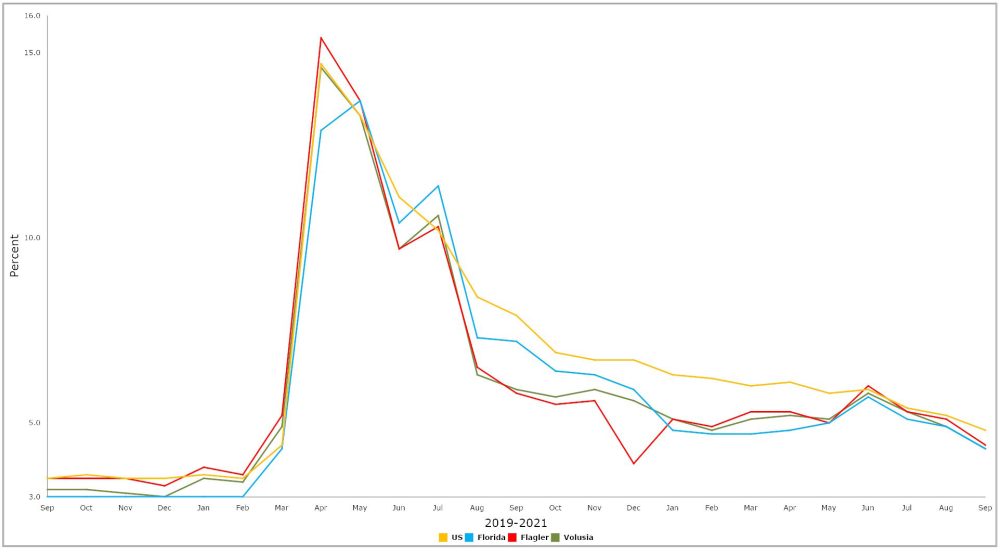
The number of people holding jobs in Flagler County rose by 304 in September, bringing the county’s unemployment rate down to 4.4 percent. The numbers in themselves are not that different from the past year’s trend, as the county’s job holders have averaged a gain of 268 per month. But it is significant in one regard: September was the first month that Flagler recovered, and exceeded, the record number of job holders in February 2020, the last month before the covid pandemic struck and cratered employment figures.
In February 2020, some 46,560 Flagler residents held jobs. In September, 46,653 did so, the highest-ever number of jobs recorded in the county’s history. The figure does not represent job creation in the county, but rather the number of residents holding jobs anywhere–in the county, in surrounding counties or through telecommuting. It also does not reflect only full-time workers, but anyone who has recorded at least an hour’s worth of paid work in the period covered by the unemployment survey.
There were 2,170 people officially without jobs in the county, compared with 1,881 in February 2020. Those officially counted among the unemployed are not representative of the actual number of people who are without work as the figure only represents those who are following the state’s stringent rules to be considered unemployed.
The county’s labor force stayed flat at just under 49,000, or 342 workers short of the record set in February 2020. The breaking of that record is a matter of months: a year ago, the labor force stood at just over 46,000. The figure represents only 42 percent of the county’s population, or almost precisely 50 percent of the population 18 and older. Some 31 percent of the county’s population is 65 and older, 16 percent is younger than 18.
In Florida, the seasonally adjusted unemployment rate for September was 4.9 percent, down 0.1 percentage point from the August 2021 rate, and down 2.3 percentage points from a year ago. Officially, there were 517,000 jobless Floridians out of a labor force of 10.6 million. As in Flagler, the numbers don;t reflect the underemployed or the unemployed who’ve dropped out of the workforce. The federal government calculates what it calls the “alternative measure of labor underutilization” by states. Florida’s unemployment and underemployment rate through the second quarter of 2021 was 12 percent, a more accurate reflection of true unemployment, as the figure is an indication of the ratio of workers who want or need full-time work but are unable or unwilling to find it. Florida’s alternative rate is one decimal point above the national rate.
Florida added 84,500 jobs in September, for a total of 406,000 jobs over the year. In Florida, the number of job holders has not yet reached pre-pandemic levels. It has gained back 83.8 percent of those jobs, or 1.06 million, after losing 1.27 million jobs from February to April 2020.
Seasonally adjusted employment figure show the biggest job gains in Florida in leisure and hospitality, with a 2.5 percent gain, or 26,600 jobs month-over-month, the majority of them in hotels, motels and restaurants. The leisure industry was the hardest hit by the pandemic. Local government had a solid gain of 1.6 percent, of 11,300 jobs. Administrative and waste services also posted solid gains, as did trade and transportation, and construction, a sector that saw an additional 6,900 jobs (likely not least helped by the ongoing construction boom in Palm Coast). There were no sectors with significant job losses.
The full report is below.
![]()
The September Unemployment Report:
Click to access september-unemployment-1.pdf




























Timothy Patrick Welch says
The buildout of Florida continues!
As more affluent retires look for a better climate.
Live Free